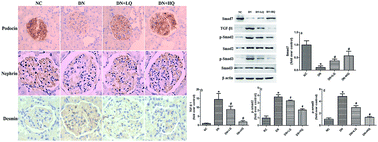Our official English website, www.x-mol.net, welcomes your
feedback! (Note: you will need to create a separate account there.)
Quercetin ameliorates podocyte injury via inhibition of oxidative stress and the TGF-β1/Smad pathway in DN rats
RSC Advances ( IF 3.9 ) Pub Date : 2018-10-16 00:00:00 , DOI: 10.1039/c8ra07935h Fanfan Gao 1 , Xin He 1 , Shanshan Liang 1 , Sixiu Liu 1 , Hua Liu 1 , Quan He 1 , Lei Chen 1 , Hongli Jiang 1 , Yali Zhang 2
RSC Advances ( IF 3.9 ) Pub Date : 2018-10-16 00:00:00 , DOI: 10.1039/c8ra07935h Fanfan Gao 1 , Xin He 1 , Shanshan Liang 1 , Sixiu Liu 1 , Hua Liu 1 , Quan He 1 , Lei Chen 1 , Hongli Jiang 1 , Yali Zhang 2
Affiliation

|
An increasing number of investigations have revealed that podocytes play a crucial role in the development and progression of diabetic nephropathy (DN). Quercetin (2-(3,4-dihydroxyphenyl)-3,5,7-trihydroxy-4H-chromen-4-one) is the most common flavonol in the diet and is one of the most prominent dietary antioxidants, which might have a protective effect on DN. The present study was designed to investigate the protective effect of quercetin on podocyte impairment in a rat model of DN, as well as underlying molecular mechanisms. All diabetic rats were induced by a single intraperitoneal injection of streptozotocin, and quercetin was administered daily at a dose of 50 mg kg−1 or 100 mg kg−1 for 12 weeks. In the present study, quercetin markedly decreased blood glucose levels, kidney-to-body weight ratio, albuminuria, creatinine clearance rate, blood urea nitrogen, and triglycerides and significantly attenuated oxidative stress. Moreover, quercetin was observed to inhibit podocyte effacement and decrease the thickness of glomerular basement membranes. Mechanistically, quercetin significantly increased the expression of podocyte-specific markers nephrin and podocin and decreased expression of the podocyte injury marker desmin in DN rats. Quercetin also inhibited activation of the TGF-β1/Smad signaling pathway in DN rats by decreasing expression of TGF-β1, p-Smad2, and p-Smad3, and increasing Smad7 expression. These findings suggest that quercetin administration ameliorated podocyte injury in DN rats, possibly by inhibiting oxidative stress and the TGF-β1/Smad signaling pathway. Thus, quercetin may be manipulated to act as a potential drug for prevention of early diabetic nephropathy.
中文翻译:

槲皮素通过抑制DN大鼠的氧化应激和TGF-β1/Smad通路改善足细胞损伤
越来越多的研究表明,足细胞在糖尿病肾病 (DN) 的发展和进展中起着至关重要的作用。槲皮素 (2-(3,4-dihydroxyphenyl)-3,5,7-trihydroxy-4 H -chromen -4-one) 是饮食中最常见的黄酮醇,也是最突出的饮食抗氧化剂之一,可能具有对DN有保护作用。本研究旨在研究槲皮素对 DN 大鼠模型足细胞损伤的保护作用,以及潜在的分子机制。所有糖尿病大鼠均通过单次腹腔注射链脲佐菌素诱导,槲皮素每日给药剂量为 50 mg kg -1或 100 mg kg -112周。在本研究中,槲皮素显着降低血糖水平、肾脏与体重比、白蛋白尿、肌酐清除率、血尿素氮和甘油三酯,并显着减轻氧化应激。此外,观察到槲皮素可抑制足细胞消失并降低肾小球基底膜的厚度。机制上,槲皮素显着增加了 DN 大鼠足细胞特异性标志物 nephrin 和 podocin 的表达,并降低了足细胞损伤标志物 desmin 的表达。槲皮素还通过降低 TGF-β1、p-Smad2 和 p-Smad3 的表达并增加 Smad7 的表达来抑制 DN 大鼠中 TGF-β1/Smad 信号通路的激活。这些发现表明,槲皮素给药改善了 DN 大鼠的足细胞损伤,可能通过抑制氧化应激和TGF-β1/Smad信号通路。因此,槲皮素可以作为预防早期糖尿病肾病的潜在药物。
更新日期:2018-10-16
中文翻译:

槲皮素通过抑制DN大鼠的氧化应激和TGF-β1/Smad通路改善足细胞损伤
越来越多的研究表明,足细胞在糖尿病肾病 (DN) 的发展和进展中起着至关重要的作用。槲皮素 (2-(3,4-dihydroxyphenyl)-3,5,7-trihydroxy-4 H -chromen -4-one) 是饮食中最常见的黄酮醇,也是最突出的饮食抗氧化剂之一,可能具有对DN有保护作用。本研究旨在研究槲皮素对 DN 大鼠模型足细胞损伤的保护作用,以及潜在的分子机制。所有糖尿病大鼠均通过单次腹腔注射链脲佐菌素诱导,槲皮素每日给药剂量为 50 mg kg -1或 100 mg kg -112周。在本研究中,槲皮素显着降低血糖水平、肾脏与体重比、白蛋白尿、肌酐清除率、血尿素氮和甘油三酯,并显着减轻氧化应激。此外,观察到槲皮素可抑制足细胞消失并降低肾小球基底膜的厚度。机制上,槲皮素显着增加了 DN 大鼠足细胞特异性标志物 nephrin 和 podocin 的表达,并降低了足细胞损伤标志物 desmin 的表达。槲皮素还通过降低 TGF-β1、p-Smad2 和 p-Smad3 的表达并增加 Smad7 的表达来抑制 DN 大鼠中 TGF-β1/Smad 信号通路的激活。这些发现表明,槲皮素给药改善了 DN 大鼠的足细胞损伤,可能通过抑制氧化应激和TGF-β1/Smad信号通路。因此,槲皮素可以作为预防早期糖尿病肾病的潜在药物。











































 京公网安备 11010802027423号
京公网安备 11010802027423号